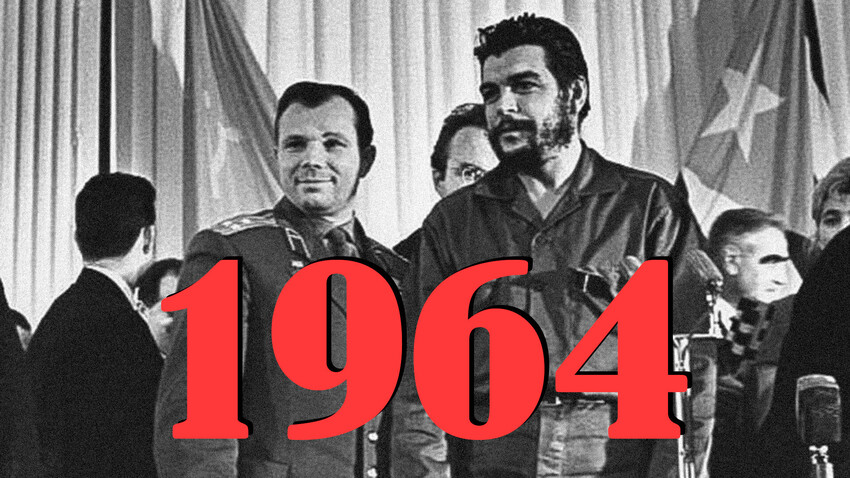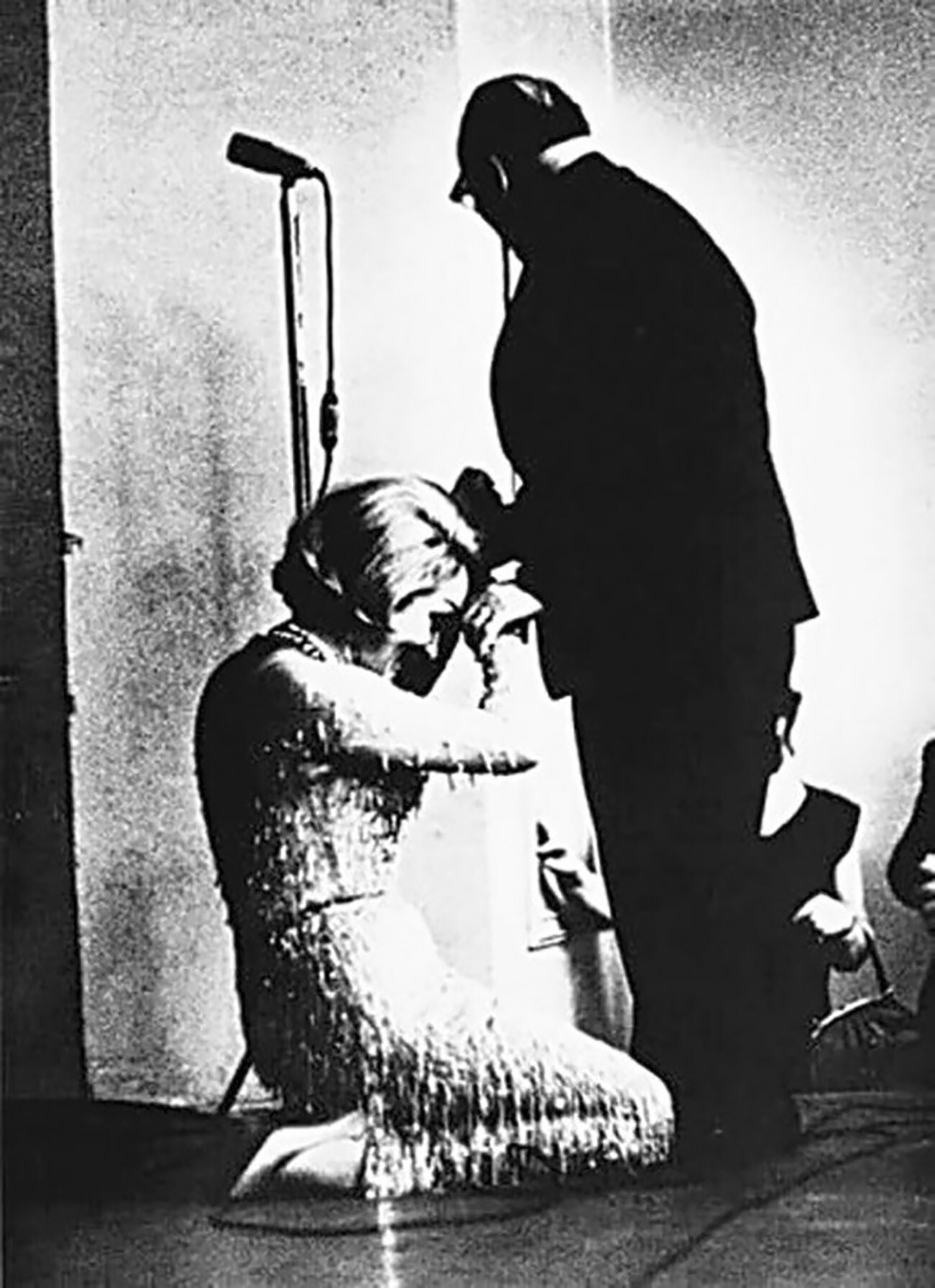
The 1960s was a time of romance and youth. The generation that had not fought in the war was now grown up and people were becoming more pacifist.
Below, you can see happy students of Moscow State University at a Labor Day demonstration.
Soviet youth would take guitars and tents and go hiking, conquering mountains and forests.
Sport and an active lifestyle was the most important component of children's physical education since the early days of the USSR. That's why skiing was a part of the school program in winter.
Large sports parades were even held on the Red Square.
In the 1960s, a huge number of photo cameras started to be mass produced, which were very affordable and easy to use, so even children had them. Pioneers at the famous Artek camp could now capture their summer vacations on film.
Even the aesthetics of photography changed during the Thaw. The photo below shows the "Main Clock of the State" on the Moscow Kremlin's Spasskaya Tower.
Only three years had passed since Yuri Gagarin's pioneering flight, so space aviation was a mass craze. The photo below depicts cadets of an aviation school.
All children dreamed of flying into space and played being cosmonauts even in kindergarten.
Cars were still considered a luxury item, but they were becoming more mass-produced and affordable. Check out the magazine advertisement for the Moskvich-408 model below.
Another important phenomenon of the 1960s was the mass construction of ‘khrushchyovka’ apartment buildings and whole new neighborhoods with such standard housing began to appear in many cities.
Many Soviet people also finally were eligible to own apartments for the first time. Even though most were small, people were happy to move into a separate living space from the communal houses and dormitories.
And, with time, more and more household comforts began to appear. For example, almost every apartment had such a Soviet ‘Uralets’ vacuum cleaner!
In 1964, several famous foreigners made historic visits to the USSR. One of them was a great friend of the Soviet Union – Cuban revolutionary Ernesto Che Guevara. In the photo below, he poses together with the main Soviet star at the time, Yuri Gagarin.
Another celebrity, German actress and singer Marlene Dietrich, also visited the USSR that year. She went to Moscow and Leningrad (on the photo shows her there) and gave a series of concerts.
At one of the concerts, a shocking incident occurred. Dietrich fell to her knees in front of Soviet writer Konstantin Paustovsky. Why would she do this? Find out here!

At the time, writers and poets were real idols in the USSR. There was a whole generation of "sixties" who were read by the whole country and who gathered entire stadiums for their performances! The photo below shows one of them, poet Yevgeny Yevtushenko.
The woman below is hardly recognizable without her uniform, but it's famous cosmonaut Valentina Tereshkova! A year before she became the first woman successfully to fly into space.
Below, another Soviet celebrity, ballerina Maya Plisetskaya, can be seen dancing the part of Kitri from the ballet ‘Don Quixote’ at the Bolshoi Theater.
In 1964, a historic event took place – the launch of the first oil extraction in Siberia. The field was developed in hard-to-reach areas of the taiga and the Ust-Balyk-Surgut oil pipeline was launched.
The remote northern city of Surgut also became a place of interest. The photo below shows the city airport.
Meanwhile, the development of new regions and territories of vast Russia continued. In some cases, specialists were assigned to the most remote places, so they took their whole family with them.
Soviet people of the time believed in a happier future and in the imminent arrival of global communism and world justice. On the streets of cities you could see, for example, such large posters stating: "The Moral Code of the Builder of Communism", which hints at working for the good of society and mutual respect.
All Soviet children joyfully joined the ranks of pioneers and vowed to serve the cause of ‘Grandpa Lenin’, the leader of the revolution.
During his term, Nikita Khrushchev launched the process of political thaw and de-Stalinization. But, in October 1964, he left office by decision of the Party. The photo below shows him standing on the podium of the Mausoleum as a Soviet leader for the last time.
Khrushchev was succeeded by Leonid Brezhnev, who would lead the country and the Communist Party for the next 18 years.

The USSR and the U.S. were in the “hot” phase of the Cold War. Therefore, it was important for the Soviet country to demonstrate its military power. Military parades were held on the Red Square every year (sometimes even twice a year).
In particular in 1964, self-propelled artillery systems and missiles of Navy submarines were paraded.
Meanwhile, the USSR engaged in direct confrontation with the United States at the Summer Olympics in Tokyo.
As a result, the U.S. took first place in the overall standings, receiving more gold medals. But, in terms of the total number of prizes, the USSR was still ahead of its rival. In the photo below is Olympic champion gymnast Larisa Latynina.
By the year 1960, an outdoor swimming pool called ‘Moskva’ was completed on the site of the blown up Cathedral of Christ the Savior in Moscow. But, 30 years later, it would be demolished to rebuild the temple. So, now, the pool only remains in photos.
At the same time, in the 1960s, the attitude towards religion softened somewhat and even international ties appeared. Thus, a session of the World Council of Churches was held in the Trinity-Sergius Lavra outside Moscow.
A fancy Moscow cafe with a neon sign…
…an overall melancholic Leningrad (now St. Petersburg).
But, no matter what year it was, women in Russia have always been beautiful!
Dear readers,
Our website and social media accounts are under threat of being restricted or banned, due to the current circumstances. So, to keep up with our latest content, simply do the following:
If using any of Russia Beyond's content, partly or in full, always provide an active hyperlink to the original material.
Subscribe
to our newsletter!
Get the week's best stories straight to your inbox